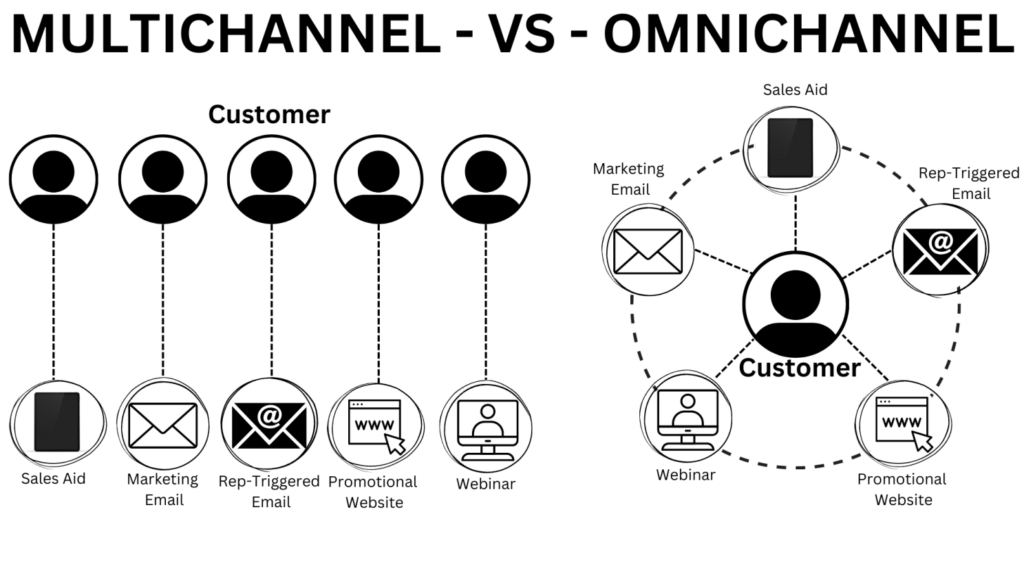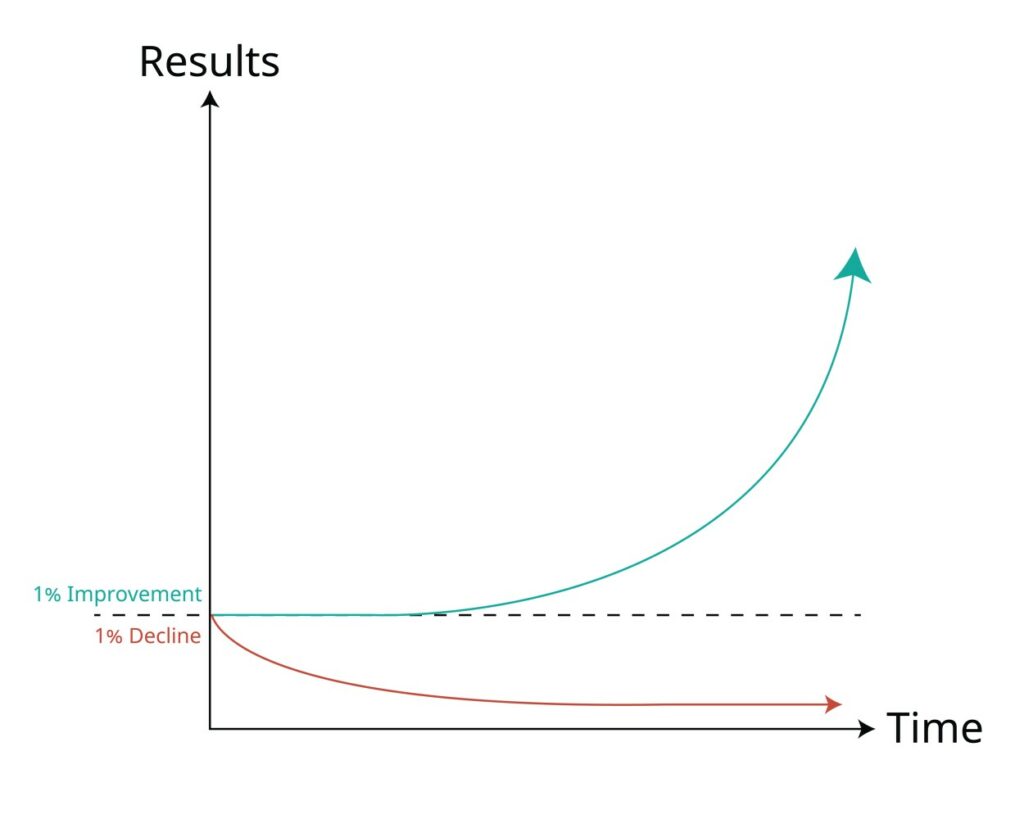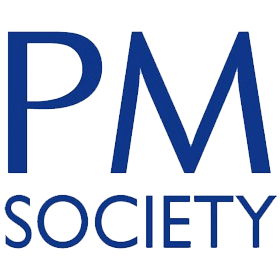This article is the eighth in a series produced by the Pharmaceutical Marketing Society’s Digital Interest Group to address some of the industry’s most pressing challenges in the digital space. They have been designed and written to inform and share good practice, but most importantly to generate discussion and collaboration.
Let’s Define and Align on Omnichannel
Whether you have clicked on this article because the title has ruffled a few feathers, or because you are in eager agreement – let’s take a step back and get on the same page by defining and aligning on what Omnichannel is.
To us, Omnichannel is a strategic concept which aims to provide a seamless, integrated experience across all channels of interaction with customers; whilst being an integrated way for cross-functional teams across the business to plan, execute and respond.

Figure 1: A Simplified Differentiation of Multichannel and Omnichannel. There are multiple touchpoints that Healthcare Professionals (HCPs) can have with a Pharma company – An omnichannel approach joins up these touchpoints so that a seamless and personalised experience can be provided.
Leaders in the eCommerce revolution, such as Amazon, pioneered this approach – think of your Amazon recommendations and shopping basket… If you add something to it on your laptop, you can pick it up right where you left off, and complete the order from your mobile, tablet or even Alexa! Seamless, and integrated. How you interact with the platform also personalises what you see on your homepage, and how you interact with the website. This level of personalisation and ease is now expected of all industries, and key stakeholders of the Pharma industry are no exception – with 84% of consumers saying an experience a company provides is as important as its products and services (SalesForce Research, 2022).
The pharmaceutical industry has undergone significant changes in recent years, with the rise of digital technologies and changing customer expectations. In this article, we will explore how pharmaceutical field teams, including sales and medical personnel, can fit into this omnichannel approach and help companies to meet the evolving needs of their customers.
The Role of Pharmaceutical Field Teams in an Omnichannel Environment – orchestrators of customer experience

Figure 2: An Illustration of a real ChatGPT conversation, asking AI to write a paragraph on the pharma rep as the orchestrator of customer experience. Please note, ChatGPT is an AI chatbot developed by OpenAI that is designed to provide human-like conversational interactions; it is trained through internet content up to September 2021, so may not consider the latest environment changes.
The orchestrator rep is nothing new, it is what good reps have always done, linking customers up to the right information and content at the right time and in response to a need. What is new, is the increase in the amount of content available, the channels we can use to share it and most importantly, the data and insights we have on our customers to better understand their needs.
Omnichannel needs to be a whole-company endeavour to work effectively, but that requires each part to be able to adjust its efforts in response to what another part is committed to doing; with field teams taking the lead on target healthcare professionals (HCPs), and marketing looking at the larger engagement funnel. Discussions need to be had about the impact of changes in field resourcing and consequences for territory size and customer targeting.
In addition to the content and channels that we use, from the customer side, HCPs channel choice has shifted. A highlight of this is that HCPs are open to using various channels and connect with Pharma remotely, with the UK leading Europe in remote engagements per week (Veeva Systems Inc., 2022), and with that the role of field teams need to evolve to accommodate HCP expectations. If the field team simply reverts back to face to face communications only, they will miss out on the interaction opportunities that remote channels offer for engagement.
Building for Future Sales Success
So what is the tangible benefit to the HCP and their patients by adopting an omnichannel strategy and mindset?
Each touchpoint with a HCP becomes a value-adding experience for both parties; HCP needs are met, which typically have downstream benefits for patient outcomes, and the relationship between the sales rep and HCP is strengthened.
At a fundamental level, we want to move away from traditional transactional interactions (single isolated engagements), to sequential value-adding experiences. This is done by understanding preferences, and using this to tailor their approach to each customer to deliver personalised experiences that build trust and loyalty.
Although HCPs may show a preference for one channel, in practice they use various channels to engage and connect with Pharma. The initial interaction to learn about a new product may be via face to face or a virtual engagement, however if they have a question or require further medical information, they may choose to do this via the company’s Medical Information service rather than directly from the rep, but the omnichannel design of their customer systems ensures their rep is immediately informed and given the opportunity to deliver the information personally. Digital asset and content has more longevity as HCPs are able to share that amongst their network to assess and evaluate its suitability for inclusion as part of the patient treatment pathway.
It takes a concerted effort to evolve the mindset, skillset and toolset of the Pharmaceutical Sales arsenal – but there are some quick-wins, and with continuous step-by-step improvements over time you will be able to shift from primarily transactional interactions, to the creation of orchestrated experiences over time. Continue reading to hear our take on some quick wins, and long-term strategic advice.

Figure 3: A Graph Illustration of the Compound Effect of Improving 1% Consistently Over Time. If you master continuous improvement and get 1% better each day for one year, you’ll end up 37 times better by the time you’re done. The same can go for the value and experiences we provide for HCPs; as we are continually competing against the HCPs last best experience, by consistently providing a step-wise improvement in value we can stand-out from our competitors in the long-term.
Pharma marketing goes hand-in-hand with sales, curating the operating environment to make the orchestrator rep a successful reality. Given how targeted field teams have become, the great majority of many medical specialties are not actively targeted; they might meet a rep or MSL at an event, but it is unlikely that they’re being called on proactively. With this as the norm in many organisations, it is critical that marketing are maintaining contact with HCPs and reinforcing their awareness where possible. But the converse also needs to happen; by connecting sales and marketing around a common planning and execution model it’s possible to ensure that target customers are left to reps to focus on rather than bombarding them with emails and other contacts at every turn.
Incorporation of Medical Teams: Challenges and Opportunities
Medical teams should also play a critical role in an omnichannel approach, providing valuable information and support to HCPs. However, incorporating medical teams into an omnichannel strategy presents different challenges to that of the sales force, such as determining what level of information can be shared with sales and other commercial teams and the need to be able to access a far broader and deeper range of medical and scientific content than reps work with.
Companies must work to overcome these challenges and identify opportunities to engage medical teams in new and innovative ways, as this will help contribute towards improving patient outcomes and HCP education. For example:
- Optimised medical education through: Webinars, online courses, virtual meetings/clinics and social media
- Use medical insights brought back to the business through cross-functional meetings to help better inform the pharma company on how to add value
- Leverage data within the CRM to identify trends and opportunities
Part of these compliance challenges have been covered in a previous article by the PM Society’s Digital Interest Group.
Mindset, Skillset, Toolset
In this section, we will give you our take on the three key areas that can have the greatest impact on organisational performance – Mindset, Skillset and Toolset.
Mindset
Most pharma companies already have a CRM that has the potential to contain the insights required to create tailored experiences, but there is a way to go in bringing everyone on that journey. As with all change, this starts with establishing a clear vision and strategy; specifically for this transition, there should be a cross-functional focus on how to integrate omnichannel practices into operation.
To start with, think about the key channels and touchpoints that HCPs interact with, and how the cross-functional Pharma teams can effectively engage with customers across these channels. By taking a strategic and proactive approach to omnichannel change management, companies can get the buy-in required for successful omnichannel adoption, which sets you up for long-term success and delivery of great personalised customer experiences.
Mindset quick wins:
- Start a workstream to ensure the CRM suite is viewed as something field-teams want to use, rather than feeling forced to use and that it is a policing tool. see the CRM as a repository of information that in time enables us to personalise our communications to HCPs.
- Have a ‘Can do’ Mindset. It takes time to master new skills particularly if the field team is apprehensive about it. Organisations need a supportive culture that encourages testing, failing and learning. It is OK not to get it right the first time.
- To achieve change, you need to provide your field teams with a blueprint and roadmap that shows them how to take the first easy steps to form new habits, and clarify what good looks like.
Skillset
When we talk about remote selling people think we did face to face selling, so people would be able to naturally get on with it. The reality is that field teams received comprehensive training for selling face to face. They had field visits by their managers coaching them. I use an analogy of driving a car to describe selling, because both selling and driving are practical skills. Most of us when we started driving, we were not confident and felt scared. With years of practice you become a confident driver. When we shifted to remote working, companies expected the sales team to take their skills and apply it to remote channels. The reality for the field time was equivalent to asking them to drive a formula one car. If you get into a formula one car without training, you either stall the car, go off track and won’t be able to drive it confidently. And that is exactly how field teams felt when faced with remote channels for engagement. They felt scared of technology, and stayed away from it and parked it hoping things would go back to normal and they could revert back to face to face selling. Companies need to invest in skill training for the field force to increase their confidence to use digital tools to get the best performance from the investment they have made in technology.
Sometimes the tools that field-teams use have just been thrown over to them with no explanation of the potential value, and how they can support in saving them time and enabling them to be better prepared for future engagements.
Skillset quick wins:
- Create a learning culture where it is OK to make mistakes and learn from digital experiences; encourage sharing of best practice as well as common mistakes, presenting these as learning opportunities.
- Ensure your digital tools training is adequate for today’s needs (virtual meeting etiquette, digital content sharing, CRM suite navigation and reporting).
- Provide soft skills training for hybrid engagement to increase field teams confidence and the ability to recreate the same chemistry they create during face to face meetings, online.
- Nurture organic Digital Champions that continually feed-back to the business and share best practice within the field-team as well as making pragmatic suggestions for tool improvement and simplification of digital steps.
- Conduct role-playing scenarios of how to use supporting materials in call to improve the likelihood of good sell outcomes.
Toolset
The tools and technology we use play a critical role in enabling effective internal strategies, and operational execution which are key to a successful omnichannel experience for HCPs. The right technology can help streamline communication channels, facilitate collaboration between teams, and deliver personalised content and support to HCPs.
For example, customer relationship management (CRM) software can help sales and medical teams track interactions with HCPs, and tailor their outreach accordingly. Digital marketing tools can enable targeted and personalised marketing campaigns that are informed by customer insights; and pulling these two sources of customer insights (e.g. through integration and analytical platforms), valuable data and insights into customer behaviour can enable an optimised omnichannel approach over time. This doesn’t stop at the system level, as the content we create plays just as important a role in enabling omnichannel experiences. By investing in the appropriate enabling technology and content, pharmaceutical companies can deliver more engaging and effective customer experiences that drive long-term success.
Toolset quick wins:
- Promote behavioural pre-call objective setting and provide soft skills training to ensure the call objectives are focused on delivering value, and the value matches the HCPs needs and pain points.
- Equip your team with Rep-Triggered Emails, test and simplify the steps required for triggering the email to increase uptake, and ask for feedback from the field team to improve the process.
- Ensure your Digital Sales Aid content is co-created, aligned to the sales process your field team are trained in and utilises functional content to capture customer insights to your CRM to enable selling and omnichannel effectiveness.
- Promote accurate call reporting to build a repository of knowledge about HCPs and personalise messages in future with.
- Keep your business intelligence reporting streamlined, part of the users workflow and that data is presented in a meaningful and actionable way (e.g centralised reports within MyInsights if you were using Veeva).
Conclusion
Across the globe, Pharma has invested in technology and digital tools to create an omnichannel experience for HCPs, but without buy-in from field teams and integration across functions, omnichannel will fail.
As the pharmaceutical industry continues to evolve, field teams must adapt to new technologies and customer expectations in order to remain effective and competitive. By enabling the rep as the orchestrator, and adopting a value driven approach using multiple channels for engagement, and providing the necessary training and support, companies can ensure that their field teams are well-equipped to meet the evolving needs of HCPs. When the needs of HCPs are met, this naturally follows through with an increase in appropriate prescribing, and ultimately improving patient outcomes.
The changes we’ve already seen to the field and go to market models employed by almost every company has both emphasised the importance of field-based teams in working with key decision makers across the HCP spectrum, but also shown the critical importance for how other parts of the organisation need to work together to ensure field teams can give key customers the necessary attention to be effective, and other HCPs do not suffer as a result. Omnichannel gives customers choice over how and where they can request or receive information, so it is imperative that reps and other field teams are given the tools to understand and act on this in order to remain in control as orchestrators.
We hope that the background, foundations and quick wins outlined in this article has been helpful – If it has, it would be great to know in the comments; and if you have anything to contribute or contest, we would be happy to have these contributions in the comments too!
Indegene. (2021). The Digitally-Savvy HCP Learnings to Engage HCPs Around the World More Effectively and Efficiently. https://resource.indegene.com/indegene/pdf/articles/the-digitally-savvy-hcp.pdf
SalesForce Research. (2022). State of the Connected Customer (5th Ed.).
Veeva Systems Inc. (2022). Veeva Pulse Field Trends Report (November 2022).
Authors: Ben Keppie – Consultant at 28b; James Harper – Founder and Managing Director at 28b.
Editors: Mehrnaz Campbell – Founder & CEO at Cheemia; Chris Wade – AVP, Strategic Solutions at Exeevo.
The PM Society is a not-for-profit organisation that believes excellent healthcare Communications lead to better outcomes for patients.
We aim to:
- Support organisations and people in healthcare
- Recognise excellence and promote best practice
- Provide education and development
Visit us HERE to learn more about the society and the value of becoming a member.
The Digital Interest Group is made up of passionate pharma digital experts who volunteer their time to:
- Promote digital best practices across pharma marketing and the wider commercial organisation
- Explore and share an understanding of what digital strategies and tactics marketers in the life sciences sector can employ effectively to support their brand, business and customers.
